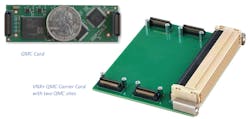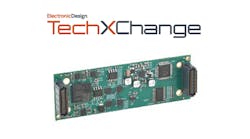QMC Modules: The Next-Generation Flexible Mezzanine Concept
What you’ll learn:
- What is VITA 93 QMC?
- Why was VITA 93 QMC created?
- Where can you use VITA 93 QMC mezzanine models?
The kickoff for VITA’s new VITA 93 QMC standard occurred at this year’s Embedded Tech Trends conference. Mark Littlefield, Director of Systems Products at Elma Electronic, gave a short introduction to the standards (watch the video above).
VITA 93 QMC is a small-form-factor mezzanine module standard that addresses rugged peripheral expansion. QMC modules are about the same size as an M.2 module (see figure), but they have a few distinct advantages, particularly for rugged environments such as applications in the military and avionics spaces.
The modules are equally applicable to commercial and industrial applications that would benefit from a more rugged solution. This is especially true where shock and vibration or other environmental issues are common.
Every module has a pair of sockets at each end and four mounting holes. The connectors, Samtec’s AcceleRate HD Ultra-Dense, Slim Body Arrays with a 0.635-mm pitch, are designed to handle high-speed serial interfaces like PCI Express Gen 6. They’re rated up to 64-Gb/s PAM4. In addition, there are pins for an IPMI link to handle platform management.
Carrier boards will fit one or more QMC modules (see table). Modules can also be x1, x2, x3, and x4 wide with each larger version adding more sockets, which provides more bandwidth. All have four mounting holes. The larger modules can be used with larger chips like GPGPUs or artificial-intelligence (AI) accelerators.
The standard also addresses cooling. The default is convention cooling; conduction cooling requires the addition of heatsinks. All form factors are part of the definition.
>>Check out this TechXchange for similar articles and videos
About the Author
William G. Wong
Senior Content Director - Electronic Design and Microwaves & RF
I am Editor of Electronic Design focusing on embedded, software, and systems. As Senior Content Director, I also manage Microwaves & RF and I work with a great team of editors to provide engineers, programmers, developers and technical managers with interesting and useful articles and videos on a regular basis. Check out our free newsletters to see the latest content.
You can send press releases for new products for possible coverage on the website. I am also interested in receiving contributed articles for publishing on our website. Use our template and send to me along with a signed release form.
Check out my blog, AltEmbedded on Electronic Design, as well as his latest articles on this site that are listed below.
You can visit my social media via these links:
- AltEmbedded on Electronic Design
- Bill Wong on Facebook
- @AltEmbedded on Twitter
- Bill Wong on LinkedIn
I earned a Bachelor of Electrical Engineering at the Georgia Institute of Technology and a Masters in Computer Science from Rutgers University. I still do a bit of programming using everything from C and C++ to Rust and Ada/SPARK. I do a bit of PHP programming for Drupal websites. I have posted a few Drupal modules.
I still get a hand on software and electronic hardware. Some of this can be found on our Kit Close-Up video series. You can also see me on many of our TechXchange Talk videos. I am interested in a range of projects from robotics to artificial intelligence.


